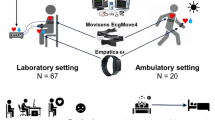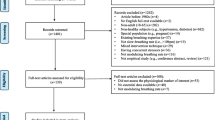Abstract
There is currently no universally recommended and accepted method of data processing within the science of indirect calorimetry for either mixing chamber or breath-by-breath systems of expired gas analysis. Exercise physiologists were first surveyed to determine methods used to process oxygen consumption (V̇O2) data, and current attitudes to data processing within the science of indirect calorimetry. Breath-by-breath datasets obtained from indirect calorimetry during incremental exercise were then used to demonstrate the consequences of commonly used time, breath and digital filter post-acquisition data processing strategies. Assessment of the variability in breath-by-breath data was determined using multiple regression based on the independent variables ventilation (VE), and the expired gas fractions for oxygen and carbon dioxide, FEO2 and FECO2, respectively. Based on the results of explanation of variance of the breath-by-breath V̇O2 data, methods of processing to remove variability were proposed for time-averaged, breath averaged and digital filter applications. Among exercise physiologists, the strategy used to remove the variability in sequential V̇O2 measurements varied widely, and consisted of time averages (30 sec [38%], 60 sec [18%], 20 sec [11%], 15 sec [8%]), a moving average of five to 11 breaths (10%), and the middle five of seven breaths (7%). Most respondents indicated that they used multiple criteria to establish maximum V̇O2 (V̇O2max) including: the attainment of age-predicted maximum heart rate (HRmax) [53%], respiratory exchange ratio (RER) >1.10 (49%) or RER >1.15 (27%) and a rating of perceived exertion (RPE) of >17, 18 or 19 (20%). The reasons stated for these strategies included their own beliefs (32%), what they were taught (26%), what they read in research articles (22%), tradition (13%) and the influence of their colleagues (7%). The combination of VE, FEO2 and FECO2 removed 96–98% of V̇O2 breath-by-breath variability in incremental and steady-state exercise V̇O2 data sets, respectively. Correction of residual error in V̇O2 datasets to 10% of the raw variability results from application of a 30-second time average, 15-breath running average, or a 0.04 Hz low cut-off digital filter. Thus, we recommend that once these data processing strategies are used, the peak or maximal value becomes the highest processed datapoint. Exercise physiologists need to agree on, and continually refine through empirical research, a consistent process for analysing data from indirect calorimetry.











Similar content being viewed by others
References
Lusk G. The elements of the science of nutrition. Philadelphia (PA): WB Saunders, 1928
Hill AV. Muscular activity. London: Tindall and Cox, 1925
Hill AV, Lupton H. Muscular exercise, lactic acid, and the supply and utilization of oxygen. Q Q J Med 1923; 16: 135–71
Bassett DR, Howley ET. Limiting factors for maximum oxygen uptake and determinants of endurance performance. Med Sci Sports Exerc 2000; 32: 70–84
Bassett DR, Howley ET. Maximal oxygen uptake: “classical” versus “contemporary” viewpoints. Med Sci Sports Exerc 1997; 2: 591–603
Bergh U, Ekblom B, Astrand P. Maximal oxygen uptake “classical” versus “contemporary” viewpoints. Med Sci Sports Exerc 2000; 32: 85–8
Howley ET, Bassett DR, Welch HG. Criteria for maximal oxygen uptake: review and commentary. Med Sci Sports Exerc 1995; 27: 1292–301
Noakes TD. Implications of exercise testing for prediction of athletic performance: a contemporary perspective. Med Sci Sports Exerc 1988; 20: 319–30
Noakes TD. Challenging beliefs: ex Africa semper aliquid novi. Med Sci Sports Exerc 1997; 9: 571–90
Noakes TD. Maximal oxygen uptake: “classical” versus “contemporary” viewpoints: a rebuttal. Med Sci Sports Exerc 1998; 30: 1381–98
Robergs RA. An exercise physiologist’s “contemporary” interpretations of the “ugly and creaking edifices” of the V̇O2max concept. JEP online 2001; 4 (1): 1–44
Cumming GR, Borysyk LM. Criteria for maximum oxygen uptake in men over 40 in a population survey. Med Sci Sports Exerc 1972; 4: 18–20
Froelicher Jr VF, Brammell H, Davis G, et al. A comparison of three maximal treadmill exercise protocols. J Appl Physiol 1974; 36: 720–5
McArdle WD, Katch FI, Pechar GS. Comparison of continuous and discontinuous treadmill and bicycle tests for maxV̇O2. Med Sci Sports Exerc 1973; 5: 156–60
Mitchell JH, Blomqvist G. Maximal oxygen uptake. New Engl J Med 1971; 284: 1018–22
Mitchell JH, Sproule BJ, Chapman CB. The physiological meaning of the maximal oxygen intake test. J Clin Invest 1958; 37: 538–46
Taylor HL, Buskirk E, Henschel A. Maximal oxygen intake as an objective measure of cardio-respiratory performance. J Appl Physiol 1955; 8: 73–80
American College of Sports Medicine. ACSM’s guidelines for exercise testing and prescription. Philadelphia (PA): Lippincott Williams and Wilkins, 2005
Wyndham CH, Strydom NB, Maritz JS, et al. Maximal oxygen intake and maximum HR during strenuous work. J Appl Physiol 1959; 14: 927–36
Beaver WL, Wasserman K, Whipp BJ. On-line computer analysis and breath-by-breath graphical display of exercise function tests. J Appl Physiol 1973; 34: 128–32
Beaver WL, LaMarra N, Wasserman K. Breath-by-breath measurement of true alveolar gas exchange. J Appl Physiol 1981; 51 (6): 1662–75
Lamarra N, Whipp BJ, Ward SA, et al. Effect of inter-breath fluctuations on characterizing exercise gas exchange kinetics. J Appl Physiol 1987; 62 (5): 2003–12
Roecker K, Prettin S, Sorichter S. Gas exchange measurements with high temporal resolution: the breath-by-breath approach. Int J Sports Med 2005; 26: S11–8
Whyte GP, Sharma S, George K, et al. Exercise gas exchange responses in the differentiation of pathologic and physiologic left ventricular hypertrophy. Med Sci Sports Exerc 1999; 31 (9): 1237–41
Day JR, Rossiter HB, Coats EM, et al. The maximally attainable V̇O2 during exercise in humans: the peak vs.maximum issue. J Appl Physiol 2003; 95 (5): 1901–7
Duncan GE, Howley ET, Johnson BN. Applicability of V̇O2max criteria: discontinuous versus continuous protocols. Med Sci Sports Exerc 1997; 29: 273–8
Dwyer DB. A standardmethod for determination of maximal aerobic power from breath-by-breah V̇O2 data obtained during a continuous ramp test on a bicycle ergometer. JEP online 2004; 7 (5): 1–9
Pearce DH, Milhorn HT, Holoman GH, et al. Computerbased system for analysis of respiratory responses to exercise. J Appl Physiol 1977; 42: 968–75
Potter CR, Childs DJ, Houghton W, et al. Breath-to-breath “noise” in the ventilatory and gas exchange responses of children to exercise. Eur J Appl Physiol Occup Physiol 1999; 80 (2): 118–24
Myers J, Walsh D, Buchanan N, et al. Can maximal cardiopulmonary capacity be recognized by a plateau in oxygen uptake? Med Sci Sports Exerc 1989; 96: 1312–6
Myers J, Walsh D, Sullivan M, et al. Effect of sampling on variability and plateau in oxygen uptake. J Appl Physiol 1990; 68: 404–10
Winter DA. Biomechanics and motor control of human movement. edition; Hoboken (NJ): Wiley Publishers, 2005
Astorino TA, Robergs RA, Ghiasvand F, et al. Incidence of the oxygen plateau at V̇O2max during exercise testing to volitional fatigue. JEP online 2000; 3 (4): 1–12
Doherty M, Nobbs L, Noakes TD. Low frequency of the “plateau phenomenon” during maximal exercise in elite British athletes. Eur J Appl Physiol 2003; 89: 619–23
Freedson P, Kline G, Porcari J, et al. Criteria for defining V̇O2max: a new approach to an old problem [abstract]. Med Sci Sports Exerc 1986; 18: S36
Weir JP, Koerner S, Mack B, et al. V̇O2 plateau detection in cycle ergometry. JEP online 2004; 7 (2): 55–62
Howley ET. V̇O2max and the plateau: needed or not? Med Sci Sports Exerc 2007; 39 (1): 101–2
Macfarlane DJ. Automated metabolic gas analysis systems: a review. Sports Med 2001; 31 (12): 841–61
Acknowledgements
No sources of funding were used to assist in the preparation of this review. The authors have no conflicts of interest that are directly relevant to the content of this review.
Author information
Authors and Affiliations
Corresponding author
Rights and permissions
About this article
Cite this article
Robergs, R.A., Dwyer, D. & Astorino, T. Recommendations for Improved Data Processing from Expired Gas Analysis Indirect Calorimetry. Sports Med 40, 95–111 (2010). https://doi.org/10.2165/11319670-000000000-00000
Published:
Issue Date:
DOI: https://doi.org/10.2165/11319670-000000000-00000




